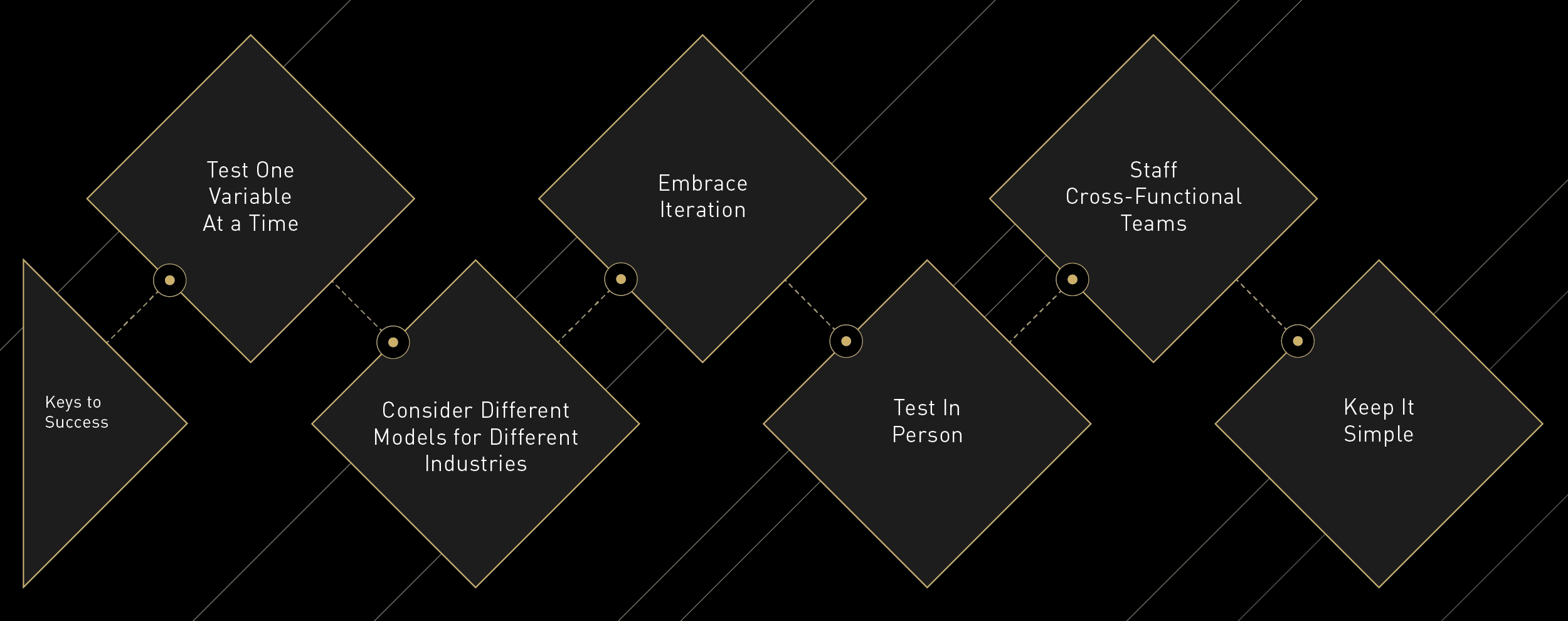Scaling a new technology or product idea is no small feat, even with a successful proof of concept under your belt. The challenge is not just creating a tangible product out of an idea – it’s also about turning that product into profit in a competitive landscape where startups are constantly shifting the game.

The process requires a healthy mix of scientific rigor and leadership, of hard facts, and bold decisions. The trick is to stay nimble, sift through the noise, and focus on what truly matters. Let’s dive into how you can successfully navigate this journey:

There’s always pressure to go to market quickly–and it’s tempting to try and cut corners by testing multiple variables at once during research. Doing so only convolutes the data and requires retesting to understand the outcomes.
For example, imagine your product is a smart light bulb that can change colors and brightness. If you test both brightness and color change simultaneously, you might get the feedback, “I don’t like the brightness,” but it could be the color that’s influencing the perception of brightness.
Prioritize the most valuable use cases of your product and approach each test with a well-defined research plan and a hypothesis. This strategy will save you time in the long run, resulting in a product that’s finely tuned to your users’ needs.

Sometimes your commercialization strategy pushes into multiple industries, all of which have their own use cases and ultimately require different models – and therefore, also, different hypotheses to test.
Let’s say, for example, Dialexa’s recent engagement creating a delivery robot. For the automotive industry, the use case was delivering car parts from a warehouse to a repair shop quickly, bypassing traffic. The hypothesis was that it would improve repair speed and reduce downtime. For the fast food industry, the use case was quick delivery of meals to customers. The hypothesis was that it would increase customer satisfaction due to reduced delivery times.
There likely won’t be a one-size-fits-all hardware solution that spans industries, and that’s okay. Each industry will have specific needs and constraints, requiring a unique approach. Allow research to influence the tweaks you make to fit the niche use cases of target industries.

Just like in software development, hardware development is an iterative process. Be prepared to prototype, test, gather feedback, and then revise your designs accordingly. Prototyping will be lower fidelity for hardware than for software. It may be as simple as adding paper buttons and keypads to test a new interaction. For a recent engagement, for example, we simulated the experience of a motion sensor where a user could wave their foot to unlock a door. We told the user this capability existed, and a researcher remotely opened the door, so it felt like the sensor existed. Imagine low-fidelity prototyping as a quick sketch of your idea. It’s less about perfection and more about giving users something tangible with which to interact.
The goal is to understand users’ responses and refine your design based on those insights. And remember, it’s a continuous cycle—experiment, learn, adjust, and repeat. This continuous cycle of learning and improving is key to creating a product that meets user needs and can stand up to real-world use. Embracing this iterative mindset can help ensure that your final product is the best version possible.

There are many remote solutions for software usability testing which glean the same level of insight as in-person testing. But with hardware, the value of being in person far outweighs being remote.
For example, going back to Dialexa’s recent engagement involving a delivery robot: we conducted tests using both remote and in-person approaches. For the remote aspect, our researchers dialed in via Zoom and observed through a video camera mounted on the robot. However, we also had researchers on the ground, striding alongside the delivery bot.
The in-person testing was a gold mine of insights. Our on-site researchers were able to note the robot’s interaction with its environment, the user, and even bystanders. This was crucial in understanding the product’s real-world performance, providing us with context that couldn’t be replicated remotely. One of the most surprising discoveries came from an unexpected audience: children. While navigating an apartment complex, the robot became a sensation, with kids shouting from their balconies, “Hello, robot!” Parents stepped out to see what the excitement was about. This interaction demonstrated the potential for spontaneous brand awareness.
Another example: imagine you’ve developed a cutting-edge wearable device. While remote testers can provide feedback on the interface and usability, only in-person testers can effectively evaluate the device’s comfort, fit, and feel. The sensory feedback from physically wearing the device is invaluable, highlighting why the in-person approach is essential in hardware testing.

The temptation of a large enterprise is to throw bodies at a problem (like the creation of a new IT-only silo) when what you really need are a variety of perspectives to refine the product experience. A diverse team will work faster and better to address the problem.
Dialexa designs teams for true partnership between hardware engineers, researchers, designers, and business stakeholders. We hire “V-shaped people” who possess a broad range of skills and deep knowledge in multiple areas related to custom product development and transformation. This includes hardware engineers who truly comprehend design, and designers who grasp the intricate demands of engineering. When everyone speaks the same language, teams are more synchronized and less falls through the cracks.
The in-person testing was a gold mine of insights. Our on-site researchers were able to note the robot’s interaction with its environment, the user, and even bystanders. This was crucial in understanding the product’s real-world performance, providing us with context that couldn’t be replicated remotely. One of the most surprising discoveries came from an unexpected audience: children. While navigating an apartment complex, the robot became a sensation, with kids shouting from their balconies, “Hello, robot!” Parents stepped out to see what the excitement was about. This interaction demonstrated the potential for spontaneous brand awareness.
Another example: imagine you’ve developed a cutting-edge wearable device. While remote testers can provide feedback on the interface and usability, only in-person testers can effectively evaluate the device’s comfort, fit, and feel. The sensory feedback from physically wearing the device is invaluable, highlighting why the in-person approach is essential in hardware testing.

There’s a running theme with each of these best practices: don’t overcomplicate it. The more collaborative your team and the freer they are to make decisions and pivot fast, the more competitive your enterprise will be with startups. To propel your idea from proof of concept to hardware commercialization is no small task, but with scientific rigor and focus, you can turn brilliant ideas into big opportunities.
ARE YOU READY TO TAKE YOUR PRODUCT IDEA FROM PROOF OF CONCEPT TO REAL-WORLD SUCCESS?
It is not easy to scale a new technology or product, especially with fierce startup competition. In the exciting world of hardware commercialization, we have the blueprint for your success. See how we helped a global manufacturer of agricultural, construction, and heavy machinery build solutions to drive incremental value to their core products.
Read the Case Study→
ABOUT THE AUTHOR

Annalisa Scharff, Product Designer, started her career in UX/UI, leading clients through workshops to identify core users, expected behaviors, and central needs, wants, goals, and anticipations for better product performance. Annalisa transitioned into a product designer at Dialexa in 2018 and has quickly developed her career into a senior management role. She now oversees a team of designers, ensuring product scope consistently aligns with the intended vision, goals, and success to drive impactful outcomes for our clients.
Connect with Annalisa on LinkedIn




